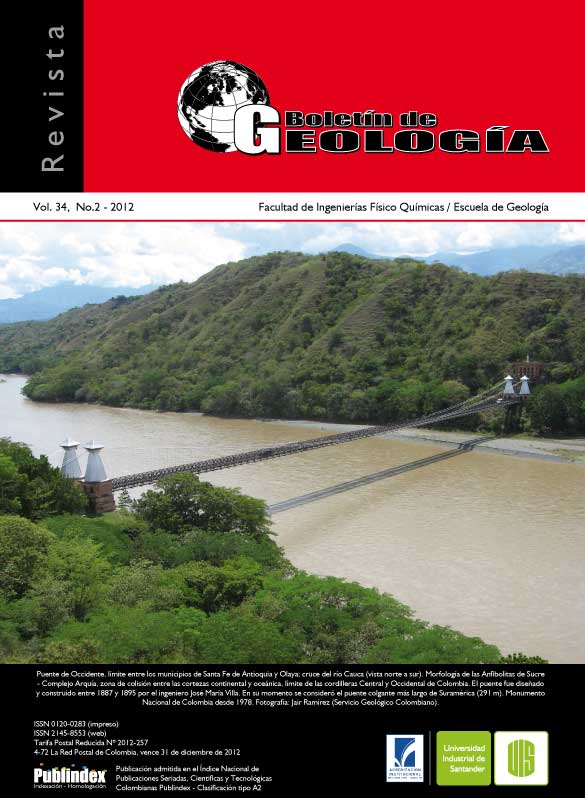AVO ANALYSIS IN THE HIGH IMPEDANCE RESERVOIR OF CHUCHUPA FIELD
Published 2013-04-01
How to Cite
Abstract
The technique of bright spot as a direct indicator of hydrocarbons has been widely used since the work of Ostrander (1984), particularly in gas fields. Located at north of Colombia, the Chuchupa field has produced gas continuously during 30 years, but despite the coverage with 2D seismic, amplitude anomalies associated with gas accumulation have not been observed. In order to find the relationships between the amplitude information and the gas accumulation, an AVO analysis was performed to describe the seismic reservoir response. The raw data of a 2D seismic line that crosses the field from East to West and a well log data set were used. In a first approach the seismic response was modeled using well logs, so a comparative analysis between the furnished synthetic seismograms and the real CDP gathers was done. The results indicated that the reservoir´s top is represented by a low amplitude peak which decreases when the offset increases but whose phase remains unchanged. In the well, where the reservoir has 100% gas saturation, a high correlation between the synthetic and real CDP gathers was observed. In a second approach, anomalous clustered points in the IV quadrant were discriminated through intercept versus gradient cross plot analysis. A weak Class-I anomaly was identified, which could not be observed in stacked sections and hence it should be analyzed using pre-stack data.
Keywords: AVO, Anomalies, Pre-stack, Reservoir, Chuchupa, Guajira.
Downloads
References
Castagna, J., Batzle, M., and Eastwood, R. 1985. Relation between Compressional-Waves and Shear-Waves Velocities in clastics Silicates Rocks. Geophysics, 50: 571-581
Castagna, J. 1997. Offset-Dependent Reflectivity – Theory and Practice of AVO Analysis: Investigation in Geophysics, No. 8. Society of Exploration Geophysicists. Tulsa, pp. 7-13
Castagna, J., Swan, H., Foster, D. 1998. Framework for AVO gradient and intercept interpretation. Geophysics, 63: 948-956
Dvorkin, J. 2006. Can Gas Sand Have a Large Poisson Ratio? SEG Expanded Abstracts 25: 1908-1912
Gassmann, F. 1951. Elastic waves through a packing of spheres. Geophysics, 16: 673-685.
Gómez, I., 2001. Structural style and evolution of the Cuisa fault system, Guajira, Colombia. University of Houston, Houston, TX, United States, Master’s thesis
Hilterman, F. 1975. Amplitudes of Seismic Waves - A Quick Look. Geophysics, 40: 745-762
Koefoed, O. 1955. On the Effect of the Poisson ́s Ratio of Rock Strata on the reflection Coefficients of Plane Waves. Geophysical Prospecting, 3: 381-387
Mosquera J., Ghisays A., and Montes, L. 2012. AVO with partial stack to detect gas anomalies in the Güepajé-3D project. En revisión - Geofisica International
Ostrander, W. 1984, Plane wave reflection coefficients for gas sands at non normal angles of incidence: Geophysics, 49: 1637-1648
Rivera, N., Meza, N., Kim, J., Clark, P., Garber, R., Fajardo, A., and Peña, V. 2007. Static and dynamic uncertainty management for probabilistic production forecast in Chuchupa field, Colombia. Reservoir Evaluation & Engineering, 10 (4): 433-439
Shuey, R. 1985. A Simplification of the Zoeppritz Equation. Geophysics, 50: 609-614.Rutherford, S., and Williams, R. 1989. Amplitude versus Offset variations in Gas Sands. Geophysics, 54: 680-688
Smith, G., and Gidlow, P. 1987. Weighted Stacking for Rock Property Estimation and Detection of Gas. Geophysical Prospecting, 35 (9): 993-1014
